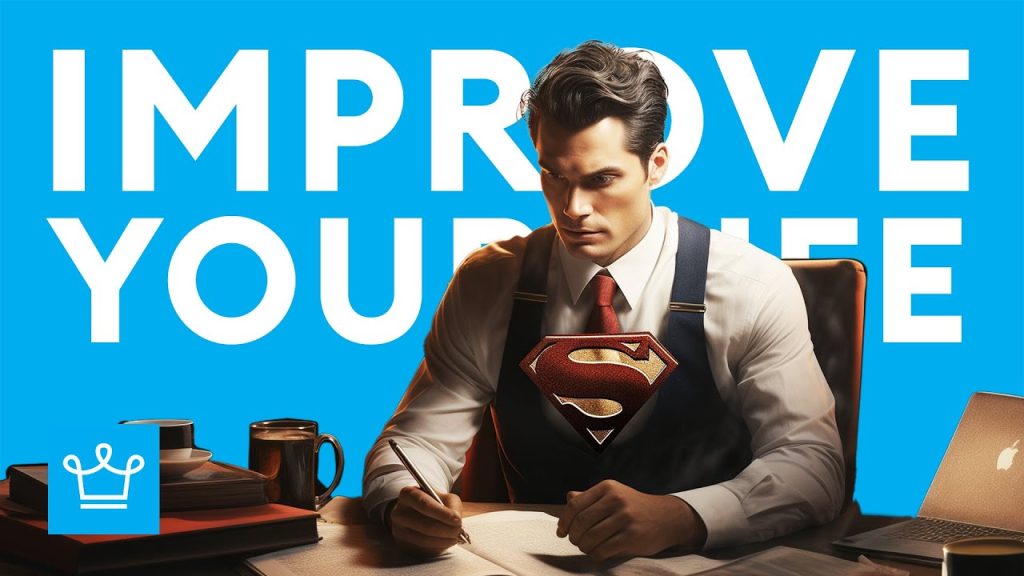If you want to start a podcast, write a book, make a game, build an app, or start anything business-related, where do you actually start?
What’s the first thing you do, and what’s the last thing you do?
There are 7 billion people on this planet, and we all have thousands of ideas. So there is no shortage of great ideas on this earth, far from it.
But what truly separates those who do, from those who don’t?
You see, it’s not money, connections, or being in the right place at the right time. Most simply do not know where to start.
They lack a simple guide to follow. So here is the simplest guide to starting anything business-related.
Don’t worry if you don’t feel like reading, you can enjoy the video below or watch it on YouTube:
1
Figure out your why
So, you’ve got this itch to start something new—a business, a podcast, or maybe even a food truck.
That’s fantastic; entrepreneurial energy is the fuel that drives innovation.
But let’s add a bit of reality into the mix.
The journey to entrepreneurship is filled with challenges, setbacks, and, at times, overwhelming doubts.
It’s not a sprint; it’s more like a marathon where resilience, not just speed, determines success.
Now, how do you build that resilience? Through inspiration.
Imagine it’s a frigid Monday morning, and the comfort of your warm bed is pulling you back, asking you to snooze the alarm one more time.
But then you remember the reason you’re embarking on this journey. It might be a passion for cooking that’s driving you to map out a food truck business. Or perhaps it’s your expertise and interest in technology that make you believe you can design a groundbreaking app.
With that inspiration in mind, suddenly the Monday blues don’t seem so intimidating.
Finding that spark of passion, and that authentic inspiration is crucial. It’s what equips you with the mental and emotional armor you’ll need to face the forthcoming challenges.
Sure, the saying “Do what you love, and you’ll never work a day in your life” sounds a bit over-the-top, but it holds a core truth.
When you love what you do, the late nights, the troubleshooting, and the customer service crises all turn from burdens into challenges—challenges that you’re excited to tackle.
Your first task, and arguably one of the most important ones to starting anything, is to dig deep into your mind.
Is it a cause, like social justice or environmental sustainability?
Is it a fascination for a particular subject matter, like artificial intelligence, fitness, or gourmet food?
Or is it simply the thrill of creating something from a mere idea—a product, a service, or a piece of art?
Once you’ve identified that inspiration, don’t let it remain a vague concept. Make it tangible.
Write it down in a notebook, on a vision board, or even in a digital document.
Make it the cornerstone on which your business plan, your work ethic, and your overall strategy are built.
Keep it front and center so that every time you hit a rough patch or a complicated decision, you have your ‘North Star’ to guide you.
In the world of business, as in life, the why is often as important as the how. Nail down your “why,” and you’ve taken the first solid step in your entrepreneurial journey.
This may sound like motivational bullcrap to you.
But how many times have you seen people suddenly wake up in the middle of their career, business, or job and say to themselves, “Wait, why am I even doing this?”
You can’t commit if you don’t know why.
2
Framing
There is a graveyard of failed businesses and forgotten great ideas because they tried to be everything. And they failed.
Before you can compete with Coca-Cola, you need a successful lemonade stand.
Framing is all about putting conscious constraints on yourself so you don’t end up all over the place, trying to do too many things all at once, and sucking at all of them.
It means putting a box around your idea and not letting it spill outside of it.
For instance, setting a hard deadline like, “I need to launch version 1 by next month,” imposes a time constraint that galvanizes your focus.
No more endless tinkering or perpetual planning—you have a target date to hit.
Or something like “I will make a podcast about growing vegetables, with these types of guests, and it will be only on YouTube”.
This gives you a clear definition of what your thing is, and what it isn’t.
You see, everyone starts a podcast now.
And everyone says their podcast is like a mix of Joe Rogan and whatever their general topic is. Which is like, okay.
So your first podcast will be just like this one, which is valued at hundreds of millions of dollars, but cooler. Got it.
You see, your first, or even all, projects, businesses, or any kind of creative endeavor should be framed around a very simple, clear, and straight message.
This is really crucial to not messing things up. Try to be everything for everyone, and you will most likely fail.
3
Brainstorming
So, you’ve ignited that spark of inspiration and framed your idea with smart constraints. What’s next?
It’s time to unleash the creative beast within you—it’s brainstorming time.
But before you dive in, let’s set one thing straight: Most people get brainstorming wrong.
They sit down and try to filter their thoughts, only allowing ‘great’ ideas to make it to the paper. That’s not brainstorming; that’s self-censoring.
We break down brainstorming into three phases.
The first phase of effective brainstorming is what we’ll call the “Open Field.” In this stage, let your imagination run wild.
Whether you’re using a laptop or scribbling on a whiteboard, jot down everything that comes to mind.
Forget judgments; forget feasibility; just let the ideas flow. Aim for quantity over quality.
You should spend around 20 to 30 minutes in this phase, and by the end, you should have a plethora of ideas—some great, some not so much.
You see, it’s an actual skill to constantly come up with stuff.
Open a Google Doc and write a page about anything without stopping. It doesn’t have to make sense or even be true. See how hard it is.
After the Open Field session, enter phase two: Organise.
You’ve got a mountain of ideas. But before you start anything, you need to sift through them.
Look for patterns, themes, or categories that emerge. It could be as simple as labeling ideas under headings like “Product Features,” “Marketing Strategies,” or “Revenue Models.”
The goal is to start making sense of the chaos.
The final phase is Elimination. This is where you get ruthless.
You’ve generated a wealth of ideas and organized them into clusters.
Now, start crossing out the ones that don’t align with your frame or aren’t inspiring enough. Keep whittling down until you’re left with a few potent, actionable ideas.
Brainstorming, when done right, is like mining for gold. Why?
Here’s our explanation of why brainstorming is such an important piece of our guide to start anything.
You start with a lot of dirt and rock, but with systematic sifting and refining, you’re left with precious nuggets—nuggets that can form the foundation of your business venture.
The point of all of this is to eventually get to the point where you have 1-2 ideas that fit your frame and that will help you in the following step.
So, for example, let’s say you decide to write and publish your own book.
The brainstorming phase could include making up a long list of potential titles for the book, potential chapters, general ideas of what could be written in each chapter, random thoughts that pop into your head, potential guests, maybe ways to market it, and so on.
If you’re starting a podcast on growing your own vegetables, a side note, we gave this as a random example, but now that we think about it, it does sound kind of interesting.
But the brainstorming for this could be titles for the podcasts, what questions will you ask the guests, a list of the top 100 ideal guests, maybe you can film it in an actual garden, who knows.
The more you keep brainstorming, the more the thing starts to take shape, and after the elimination process, you should be left with something that starts phase 4.
4
Prototype
Imagine your crush comes over on short notice, and you have 5 minutes to tidy up your place.
That’s how the prototype should feel.
In business terms, the prototype is called an MVP, or minimum viable product.
Think of it as the most bare-bones, easiest-to-make, version of whatever you’re trying to do.
Take a food truck business, for instance.
Your brainstorming session probably yielded dozens of menu items, but for an MVP, you’d narrow it down to two or three key dishes.
Once you’ve got those recipes, it’s not about perfecting them; it’s about getting them out there. Test your dishes at a local event, a friend’s party, or even a small street corner setup.
The aim is to start gathering real-world feedback as soon as possible.
If you’re venturing into the tech world, think of it as releasing an alpha version of your app or software.
The MVP could even be a simple video demo showcasing the basic functionalities and design—just enough to get people talking and interested.
The key is speed and agility.
Prototyping is about making your idea touchable, usable, and, most importantly, testable.
It’s not about getting every detail perfect; it’s about validating whether the core concept has merit.
- Do users find it useful?
- Is it solving a problem or fulfilling a need?
These are the questions you need answers to, and fast.
By putting a prototype in front of real users, you’ll get invaluable insights that you simply can’t get from brainstorming or planning alone.
Consider this phase as your first interaction with the market and, therefore, a crucial step in refining your business idea.
5
Testing
You’ve come a long way: your inspiration is robust, your framing is sharp, your ideas are crystallized, and you’ve even prototyped your Minimum Viable Product (MVP).
So, what’s the next move?
It’s time for the rubber to meet the road.
You need to test your prototype in real-world conditions. This is the phase that separates the ‘could-bes’ from the ‘will-bes’ in the business world.
At this stage, you have a functional, albeit basic, version of your product or service.
Now, you need to expose it to the harshest critic out there: the market.
Your MVP might look excellent on paper or in a controlled environment, but real-world dynamics have a way of revealing flaws you might not have considered.
Testing is essential for starting anything. So how do you test effectively?
Firstly, identify the platform or environment where your product or service will operate.
If it’s an app, get it onto the app stores, perhaps as a beta version.
For a physical product, get it into the hands of potential consumers, maybe through samples or a limited release.
If it’s a podcast, upload a couple of episodes to relevant platforms and see how listeners react. Feedback is your currency in this phase.
Collect as much of it as you can through surveys, direct interactions, or even social media mentions.
Don’t just rely on friends and family; their feedback, while valuable, will be biased. You need a wider spectrum of opinions to make informed decisions.
Remember, the primary goal here is not to validate how amazing your product is but to identify its weaknesses.
- Where did users get stuck?
- What did they wish was different?
These insights provide a roadmap for your next steps.
Testing can be both exhilarating and nerve-wracking, but it’s essential.
It equips you with the real-world data you need to refine, reiterate, or, in some cases, pivot your business idea.
If you skip this step, you’re essentially flying blind, and in the unforgiving world of business, that’s a risk you can’t afford.
Think of it like measuring 10 times and cutting once. Even movies are tested with a small, selected audience first before releasing them to the public.
And finally, we have
6
Iterating
You’ve sparked an idea, framed it with purpose, brainstormed possibilities, created a prototype, and even tested it out in the real world.
Think you’re done? Think again.
In the business arena, the finish line is always moving, and this is where the concept of iteration comes into play.
Iteration is essentially fine-tuning your Minimum Viable Product (MVP) based on the feedback and data you’ve gathered during the testing phase.
This is the stage that turns good products into great ones and average services into market leaders.
After exposing your MVP to real-world conditions, you’ll have gathered a wealth of insights, both positive and negative. It’s time to put those insights to work.
Maybe your users found a feature confusing, or perhaps they felt that something essential was missing.
These aren’t setbacks; they’re opportunities. Now you know exactly what to fix, add, or remove to make your offering more aligned with market needs.
The goal of iteration is not just to make incremental changes but to evolve your product in a way that amplifies its strengths and minimizes its weaknesses.
And remember, iterating is not a one-off process. The most successful businesses are always iterating and evolving.
Iterating is something you need to KEEP DOING. Don’t just stop at doing it once when you start anything then leave it be.
Whether it’s tech giants like Apple, or nimble startups that grew into industry disruptors, they all understand the power of iteration.
Iteration can be as simple as removing a feature that users find redundant or as complex as adding a new service line based on user demand.
The key is to act swiftly but thoughtfully, making data-driven decisions that bring you closer to a product-market fit.
And there you have it. This is the most simple yet solid guide to starting absolutely anything.
Now, what separates great people from average ones is just how well they go through this process multiple times until they have something solid.
Depending on your industry, there may be particulars. But they are still based on this foundation.
You simply cannot miss it if you use this guide properly.
Now you’re fully aware of how to keep moving once you start anything business-related. Make sure you save this article and come back to it whenever you need a refresher. See you next time!






